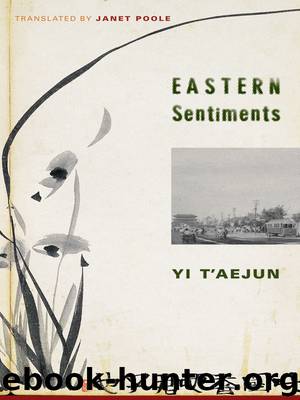Eastern Sentiments by T'aejun Yi

Author:T'aejun Yi
Language: eng
Format: epub
Tags: HIS050000, History/Asia/Central Asia, LIT008000, Literary Criticism/Asian/General
Publisher: Columbia University Press
Published: 2009-06-30T16:00:00+00:00
* Su Dongpo (1037–1101) was one of the greatest poets and calligraphers of the Song dynasty.
Copying
At the mention of Wandang I followed the duke Sŏnbu, who spends his time rummaging around scroll-mounting shops, to a certain house in order to take a look at Wandang’s calligraphy.† It was an eight-part folding screen in semicursive style mounted onto a scroll, and as we unfolded it bit by bit a heavenly elegance filled the room, removing all doubt as to whether this was the real thing with the writer’s seal affixed or not. Reluctant to leave just like that, Sŏnbu borrowed some thin rice paper and copied two of the screens in pencil. One screen read, in large script, “The ways of Heaven are pure and strange,” followed by two lines in smaller script, which read, “the manifestations of the strange ways in reality are cleverly likened to the lotus flower.” The other read, in large script, “A fragment of stone alone in the clouds,” accompanied by “the heart of a sage is like a jewel in a deep pool.” As it was Wandang’s work, not one stroke was sloppy, and the short phrases evoked a thousand fathoms of implication. With meanings as endless as the great ocean held in just two or three characters, and a majestic sculptural beauty in the shape and body of each one, there is no doubt that Chinese characters are far too great to be evaluated in a purely utilitarian fashion. We did not even copy the phrase “At the never-ending stream below the mountain, we make an offering to those in the mountain, and with the gourd dippers we brought along we each take the moon with us.” I wanted to recite such phrases as a prayer.
It was the duke Sŏnbu who made the copy, but it was I who first tried to write it in ink on paper. There was no way that I could form the strokes as in the original. I felt as if I were watching a film in fragments, and there was no way to bring it to life. Yet, seen from afar, the simple shape of the characters at least was excellent. I am rarely able to be at home during the day, but at night they seemed even more alike. To write out these two screens of twenty-four characters took me more than three hours on two separate evenings. I was imprisoned for two evenings in the strokes that Wandang had brandished so freely. For two evenings I had experienced the power of his writing, his purpose and its aftermath. I was able to memorize the strokes as I became familiar with the way the characters for heaven and for lonely flowed. It was as if I were touching the beast that was Wandang’s stroke of the hand. I realized that if we want to discern a painting or calligraphic style, we need to understand the style of the original artist. In order to do so, copying, rather than looking, is by far the shortest path.
Download
This site does not store any files on its server. We only index and link to content provided by other sites. Please contact the content providers to delete copyright contents if any and email us, we'll remove relevant links or contents immediately.
| Books & Reading | Comparative Literature |
| Criticism & Theory | Genres & Styles |
| Movements & Periods | Reference |
| Regional & Cultural | Women Authors |
4 3 2 1: A Novel by Paul Auster(12329)
The handmaid's tale by Margaret Atwood(7705)
Giovanni's Room by James Baldwin(7250)
Asking the Right Questions: A Guide to Critical Thinking by M. Neil Browne & Stuart M. Keeley(5708)
Big Magic: Creative Living Beyond Fear by Elizabeth Gilbert(5676)
Ego Is the Enemy by Ryan Holiday(5346)
The Body: A Guide for Occupants by Bill Bryson(5027)
On Writing A Memoir of the Craft by Stephen King(4892)
Ken Follett - World without end by Ken Follett(4682)
Adulting by Kelly Williams Brown(4530)
Bluets by Maggie Nelson(4510)
Eat That Frog! by Brian Tracy(4482)
Guilty Pleasures by Laurell K Hamilton(4392)
The Poetry of Pablo Neruda by Pablo Neruda(4063)
Alive: The Story of the Andes Survivors by Piers Paul Read(3996)
White Noise - A Novel by Don DeLillo(3980)
Fingerprints of the Gods by Graham Hancock(3964)
The Book of Joy by Dalai Lama(3943)
The Bookshop by Penelope Fitzgerald(3810)
